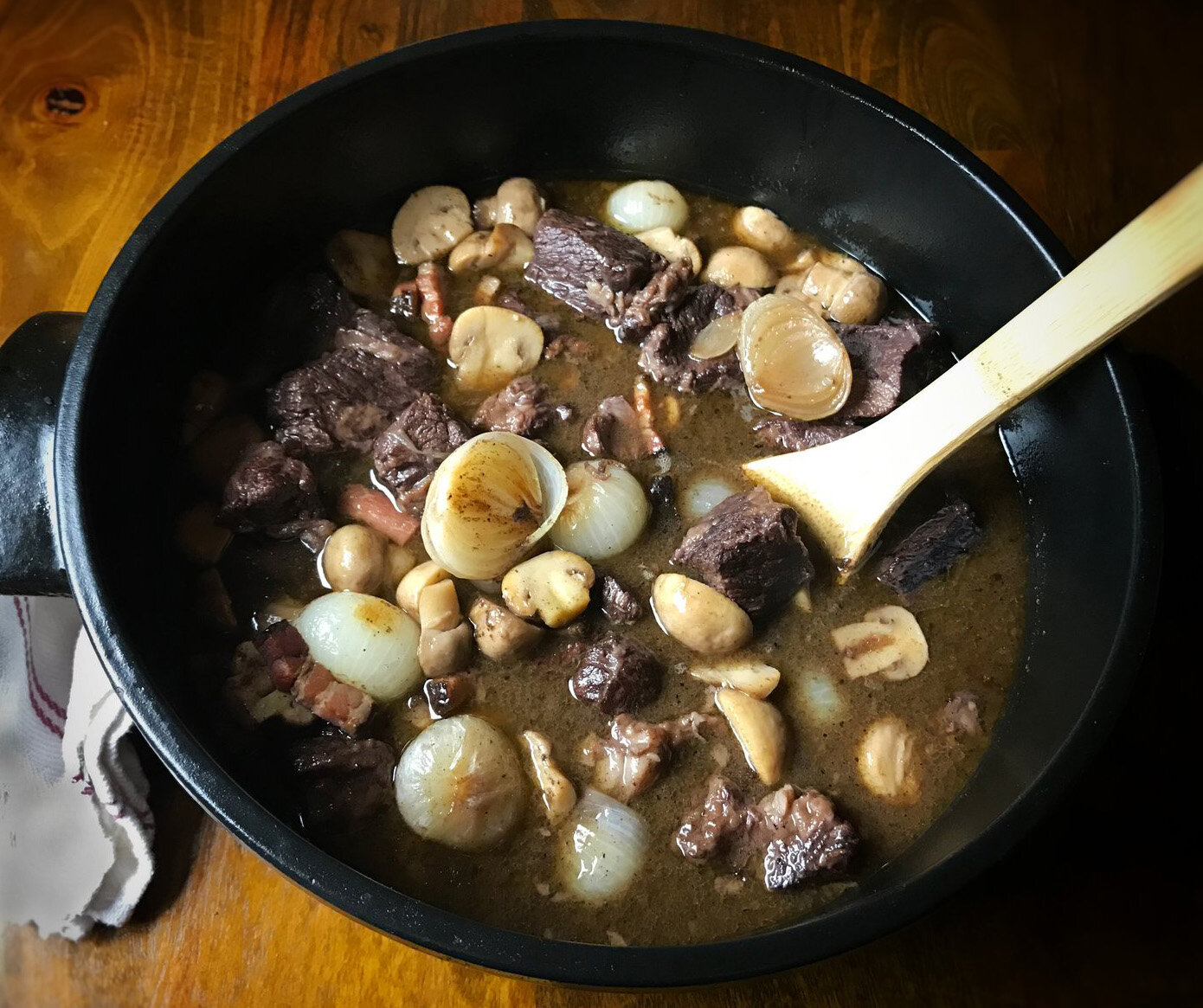By Leslie Brenner
[Note: Originally published Dec. 19, 2016, this article was updated Dec. 7, 2022.]
For as long as I've been a cook, I've been making boeuf bourguignon – the classic French wine-braised beef stew with mushrooms, lardons and baby onions. There's something so deeply soulful about the dish, which simmers for a couple of hours in the oven, filling the kitchen with an incredible aroma.
Those transporting scents always deliver on their promise: Beef bourguignon, a dish that coaxes maximum deliciousness from humble ingredients, is a dreamy dish to serve to friends – with good red wine and a loaf of crusty French bread for soaking up the fabulous, richly flavored sauce. It's impressive enough for any important celebration – such as Christmas Eve or New Year's Eve – or no occasion at all. Maybe it's just what you want to eat on a cold winter evening with a fire going in the fireplace. It's a dish that never shows off, but always thrills. And while it may look like a lot of steps, it's no more complicated or time-consuming than making chili.
And because you can completely make it ahead – even the day before – it's the ideal (stress-free!) dish to serve at a dinner party, along with boiled or roasted potatoes or buttered noodles. Precede it with a wintry salad, céleri rémoulade or a super easy-to-make yet luxurious and velvety roasted cauliflower soup swirled with brown butter.
I must have originally learned to make beef bourguignon from Julia Child's Mastering the Art of French Cooking, but over the years, I've played with the recipe, trying to answer the questions that inevitably nip at a cook's heels: What's the best cut of beef to use? What kind of wine? Should you marinate the beef or not?
After so many years, and so many versions – abetted by a recent round of reading and more playing – I think I finally have my be-all-and-end-all version.
Let's start with the red wine. You use a whole bottle, so you'd better use something really good, right? Well, no – happily, it doesn't much matter what you use, as long as it hasn't turned to vinegar. I never spend more than $8 or $9 dollars on the wine for this dish. It doesn’t even have to be French.
For the beef cuts, I had to abandon my beloved Julia, who calls for "lean stewing beef." Mais, non! – what you want is a fattier cut, like beef chuck, which will become super-tender as its collagens break down through its long braise. Lean stewing beef becomes hard and tough.
From Anne Willan, author of many wonderful cookbooks and head of La Varenne cooking school in Burgundy, I gleaned the idea of using a combination of chuck and beef shank. In her fine recipe in The Country Cooking of France (2007), Willan calls for boneless beef shank. An excellent choice, if you can find the cut. (I used to be able to reliably, but not recently; our recipe includes instructions for whether you have one or not.)
An article on Serious Eats freed me from the notion that marinating the meat was worthwhile, so I scrapped that step — which shortens the process by an entire day. And rather than browning each side of the cubes of beef — which is time-consuming and dries them out — I just brown two sides, and leave them in bigger chunks. It results in a texture that’s softer and more appealing, while still getting plentyof the wonderful, flavor-enhancing caramelization of browning. A lazy person's solution that pays off!
Ready to cook?
Here's the way it'll go, in a nutshell. Brown the meat, then lightly cook your aromatic vegetables – onion, celery and carrot – which you don't even have to dice (just cut 'em in a few pieces), and a little garlic. Deglaze the pan with red wine, then add back the meat, the rest of the bottle of wine, and some chicken broth (homemade beef broth would be even better if you have it, but I never do). Toss in a bouquet garni (herbs, peppercorns and bay leave tied up in cheesecloth), bring to a simmer, then shove it in a slow oven for almost two hours, nearly unattended (just just want to stir it once or twice). Skim off the fat, discard the aromatic vegetables and bone, strain the sauce and add the meat back in, then add the garnishes you've prepared: lardons, mushrooms and baby onions, and braise another half hour.
There’s actually not much work involved; time does the flavor-building for you. If you want to do most of it a day or two in advance, you can stop and refrigerate it after the two hours in the oven; the day you’re ready to finish and serve it the fat will have solidified and you can lift it right off, add the garnishes and braise it another half hour before sending it out.
Serve it, as the French do, with mashed potatoes (they call it pommes purées), buttered egg noodles or boiled potatoes, plus crusty bread. And this is the moment to pull out that great bottle of red.
Add friends or other good company, and the payoff is nothing short of awesome.
If you like this, you might enjoy:
READ: Chef Daniel Boulud gives a humble French dish, hachis Parmentier, the royal treatment
READ To make a traditional gratin dauphinois, step away from the cheese
RECIPE: Café Boulud Short Ribs with Celery Duo
RECIPE: Céleri Rémoulade



